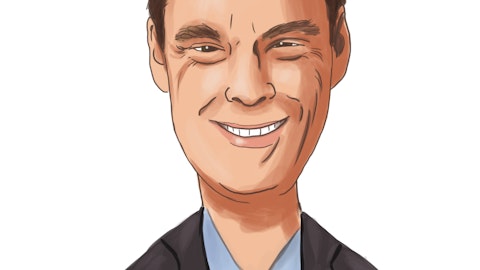David Strauss: Great. Thanks for the color. And then you mentioned the better win rate on recompetes. Can you just talk about the kind of level set us where we are in terms of recompetes, how much of the pipeline going forward is up for recompete? What do you reason recompete win rates have trended €“ how they have trended?
Prabu Natarajan: Our recompetes, they always tend to be lumpy depending on what’s in the mix. I would say, in general, we have said 10% to 20% of the portfolio comes up for recompete in a given year. And we see next year is no different from that. Obviously, the timing of Vanguard and PVMRO is going to have some level of outsized impact on those percentages, but that’s nominally what we are seeing in this business.
Operator: And your next question comes from the line of Matt Akers from Wells Fargo. Your line is open.
Matt Akers: Yes. Hey. Good morning guys. Thanks for the question.
Nazzic Keene: Good morning.
Matt Akers: I wanted to ask about some of your comments on M&A. In the prepared remarks, it sounds like it’s going to be less of a focus. Can you just talk about what you are seeing in the market there? And I mean are assets kind of more expensive, or are there more bidders? And to the extent that you still do maybe smaller deals, are there specific areas that you think are sort of focused areas you would look at?
Nazzic Keene: Yes. Let me tackle a couple of those and then Prabu can add some color. I think in general, the M&A market continues to be active. So, there are certainly assets that come to market. We certainly look at some. We don’t look at some. Interest rates, obviously, have the potential of creating some volatility in the M&A market, but we haven’t seen it to-date. So, I would say the market for the most part is pretty much what we have seen in the last couple of years. With that being said, as I think about SAIC’s interest, it would be along the lines of the GTA areas of focus that we have highlighted. So, as I mentioned in my prepared remarks, if an asset were to come to bear that accelerates, our ability to drive profitable organic growth in those areas of our portfolio where we have decided, we believe is in our best interest to grow.
Those would be of interest to us. Obviously, anything we do, we go through in a very intense process to make sure that it’s not just good for the company and the employees, but also for our shareholders. But those would be the types of assets that we would be interested in and we would be very, very selective as we looked at M&A right now.
Matt Akers: Okay. Great. Thanks. And then I guess I want to ask about Counter-UAS. I know there was the demo the other day. But if you could talk about maybe how big kind of that potential market is and any kind of big opportunities you see coming up in that market?
Nazzic Keene: Yes. We are very excited about the market. It is €“ as we highlighted in our last call, I believe it was, it is an area that we have been providing services in over the last several years. But as we sit here today, we have developed, what I believe, is a very compelling solution. We had the opportunity to show many of you over the course of the last week. And actually, I was down there a month or two months ago and got a chance to see it as well. And it’s really exciting stuff. With that being said, this particular solution set is relatively new. We are working very close with the DoD, obviously, to position ourselves. We are very proud of the fact that we are one of the three solutions as recognized by the Army in providing holistic solutions, end-to-end solutions.
But at this point, I would say it’s too early to tell what we €“ where we think that market is. We are doing a lot of work to assess that. It is a relatively small revenue set for us today. But we do see it as an opportunity to grow. It is consistent with our strategy, especially in the systems integration space. And clearly, it is an area in which not just the U.S. government, but in support of other governments as well, we believe there is a great market access. So, more to come on it and happy to share more as we learn more, but that’s how we sit here today. But very excited by it, and very proud of what the team has been able to accomplish there.
Matt Akers: Great. Thank you.





